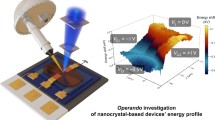Abstract
We apply antilocalization measurements to experimentally study the interactions and exchange between InAs surface accumulation electrons and local magnetic moments of the rare earth ions Sm3+, Gd3+, Ho3+, and Dy3+, of the transition metal ions Ni2+, Co2+, and Fe3+, and of Fe3O4 nanoparticles and Fe3+-phthalocyanine deposited on the surface. The influence of the deposited species on the surface electrons is observed through the changes in the spin–orbit scattering and magnetic spin-flip scattering rates, which carry information about magnetic interactions. Experiments indicate a temperature-dependent magnetic spin-flip scattering for Ho3+, Dy3+, Ni2+, and Co2+. Concerning the spin–orbit scattering rate, we observe an increase, except for the cases of Ni2+, Fe3+, Fe3O4 nanoparticles and Fe3+-phthalocyanine. We also observe an increase in SO scattering in another system where we study the interactions of Au nanoparticles and ferromagnetic Co0.6Fe0.4 nanopillars and an In0.53Ga0.47As quantum well. Experimental results are analyzed and compared to theoretical models. Our method provides a controlled way to probe the quantum properties of two-dimensional electron systems, either on the surface of InAs or in a quantum well.





Similar content being viewed by others
References
Zhang Y, Kallaher RL, Soghomonian V et al (2013) Measurement by antilocalization of interactions between InAs surface electrons and magnetic surface species. Phys Rev B 87:054430
Wei W, Bergmann G (1988) CuCo: a new surface Kondo system. Phys Rev B 37:5990–5993
Gang T, Deniz Yilmaz M, Atac D et al (2012) Tunable doping of a metal with molecular spins. Nat Nanotechnol 7:232–236
He HT, Wang G, Zhang T et al (2011) Impurity effect on weak antilocalization in the topological insulator Bi2Te3. Phys Rev Lett 106:166805
Lu HZ, Shi JR, Shen SQ (2011) Competition between weak localization and antilocalization in topological surface states. Phys Rev Lett 107:076801
Bergmann G (1984) Weak localization in thin films: a time-of-flight experiment with conduction electrons. Phys Rep 107:1–58
Hikami S, Larkin AI, Nagaoka Y (1980) Spin–orbit interaction and magnetoresistance in the two dimensional random system. Prog Theor Phys 63:707–710
Iordanskii SV, Lyanda-Geller YB, Pikus GE (1994) Weak localization in quantum wells with spin–orbit interaction. Pis’ma Zh Eksp Teor Fiz 60:199–203
Haesendonck CV, Vranken J, Bruynseraede Y (1987) Resonant Kondo scattering of weakly localized electrons. Phys Rev Lett 58:1968–1971
Licini JC, Dolan GJ, Bishop DJ (1985) Weakly localized behavior in quasi-one-dimensional Li films. Phys Rev Lett 54:1585–1588
Dugaev VK, Bruno P, Barnas J (2001) Weak localization in ferromagnets with spin–orbit interaction. Phys Rev B 64:144423
Acknowledgments
The authors thank Prof. Judy Riffle for providing the decorated Fe3O4 nanoparticles. The work was supported by the U.S. Department of Energy, Office of Basic Energy Sciences, Division of Materials Sciences and Engineering under Award (DOE DE-FG02-08ER46532).
Author information
Authors and Affiliations
Corresponding author
About this article
Cite this article
Zhang, Y., Soghomonian, V., Kallaher, R.L. et al. Antilocalization sensing of interactions between two-dimensional electrons and surface species. Chin. Sci. Bull. 59, 133–137 (2014). https://doi.org/10.1007/s11434-013-0035-2
Received:
Accepted:
Published:
Issue Date:
DOI: https://doi.org/10.1007/s11434-013-0035-2




